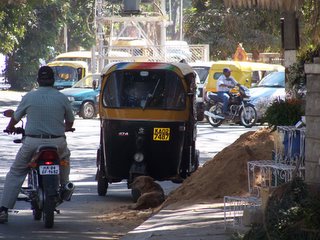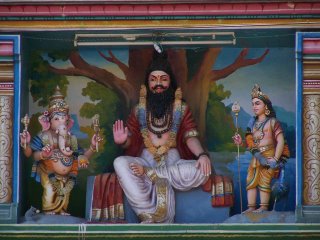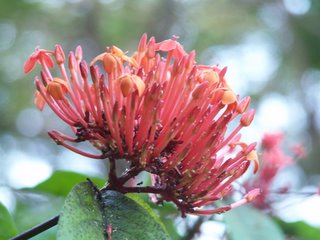Tremendous Source of Inspiration
Three days after I arrive home I get the following email:
Dear Mr. Williams,
It was indeed a pleasure having you stay with us during your recent visit to Bangalore.
We thank you for sparing your valuable time to complete our Guest Questionnaire, which has been forwarded to us by our Chairman for action and response.
It is motivation from discerning patrons such as you, which encourages us to give our best. It has also been our utmost focus at The Oberoi, Bangalore to provide our valued guests with personalised service that meets high standards of hospitality.
I have conveyed your gracious compliments to Sreeram, for whom it has been a tremendous source of inspiration.
I look forward to the pleasure of your continued visits and assure you of our best services at all times.
Thank you,
Yours sincerely,
[name deleted]
General Manager
The Oberoi, Bangalore
Friday, February 17, 2006
The Emerald Route
Delayed for a few weeks in jotting down the following:
Leaving Bangalore tonight on the 2:30 AM flight back to Frankfurt. Total flight time between here and home, 22 or so hours. I buy a copy of “The Emerald Route” by R.K. Narayan at Hal Airport and skim a few pages while watching a TV special about the inherent insecurity of India’s security forces.
I stumble on the following passage about Bangalore:
“The hoary nucleus of the city retains an indescribable charm, although the architecture may look outdated, and one’s passage at first may appear hazardous through it’s traffic, but actually the wheels steer off within a hair’s breadth and spare the pedestrian’s toes, who must survive by lightly leaping aside, and recovering his balance from the very edge of the granite pavement, and may not suffer more than an occasional jab from a cycle handle or a bump from its mudguard as crack-riders dash past, weaving their way through.”
 This was 1977 of course, when Narayan was writing, before the advent of the autorickshaw which is by far the most prevalent vehicle on the streets of Bangalore. 75,000 of these or so are registered with the city government, but estimates of actual numbers on the streets range into the multiple hundreds of thousands. This was 1977, when the population of Bangalore was just over two million, while today it is greater than six million.
This was 1977 of course, when Narayan was writing, before the advent of the autorickshaw which is by far the most prevalent vehicle on the streets of Bangalore. 75,000 of these or so are registered with the city government, but estimates of actual numbers on the streets range into the multiple hundreds of thousands. This was 1977, when the population of Bangalore was just over two million, while today it is greater than six million.
At no time did I ever feel safe crossing the street or riding in a car, though my driver, Anish, was a consummate pilot: calm and cool, and often quite strategic in his lane swapping and vehicle passing. Most of the time, however, I kept my eyes closed. When I commented multiple times on the traffic, I was told that if you ever doubted the existence of a higher power, go to India and watch the traffic work - it just works - inexplicably.
I sleep on the plane a few hours, then wake up and become completely absorbed in a Bollywood flick, No Entry, which is mysteriously captivating.
All is well until I eat something on the plane that in turn has me waylaid for the next three days.
Leaving Bangalore tonight on the 2:30 AM flight back to Frankfurt. Total flight time between here and home, 22 or so hours. I buy a copy of “The Emerald Route” by R.K. Narayan at Hal Airport and skim a few pages while watching a TV special about the inherent insecurity of India’s security forces.
I stumble on the following passage about Bangalore:
“The hoary nucleus of the city retains an indescribable charm, although the architecture may look outdated, and one’s passage at first may appear hazardous through it’s traffic, but actually the wheels steer off within a hair’s breadth and spare the pedestrian’s toes, who must survive by lightly leaping aside, and recovering his balance from the very edge of the granite pavement, and may not suffer more than an occasional jab from a cycle handle or a bump from its mudguard as crack-riders dash past, weaving their way through.”
 This was 1977 of course, when Narayan was writing, before the advent of the autorickshaw which is by far the most prevalent vehicle on the streets of Bangalore. 75,000 of these or so are registered with the city government, but estimates of actual numbers on the streets range into the multiple hundreds of thousands. This was 1977, when the population of Bangalore was just over two million, while today it is greater than six million.
This was 1977 of course, when Narayan was writing, before the advent of the autorickshaw which is by far the most prevalent vehicle on the streets of Bangalore. 75,000 of these or so are registered with the city government, but estimates of actual numbers on the streets range into the multiple hundreds of thousands. This was 1977, when the population of Bangalore was just over two million, while today it is greater than six million.At no time did I ever feel safe crossing the street or riding in a car, though my driver, Anish, was a consummate pilot: calm and cool, and often quite strategic in his lane swapping and vehicle passing. Most of the time, however, I kept my eyes closed. When I commented multiple times on the traffic, I was told that if you ever doubted the existence of a higher power, go to India and watch the traffic work - it just works - inexplicably.
I sleep on the plane a few hours, then wake up and become completely absorbed in a Bollywood flick, No Entry, which is mysteriously captivating.
All is well until I eat something on the plane that in turn has me waylaid for the next three days.
Thursday, February 02, 2006
Wednesday, February 01, 2006
Wolves
Enjoyed an impossibly good-to-great Chinese dinner (salt and pepper shrimp, salt and pepper squid, chicken with black bean sauce) with the team and with a friend from Chapel Hill (by way of Amsterdam). The woman across the dining room from us read her fortune out loud to her children and I could read her lips: “It’s always darkest before the dawn.”
Back to the Polo Club for a Guinness. Sreeram pours me a beer. He is still charging his phone on the bar in plain view of everyone, though it must be charged by now, as I’ve never seen him use it. I read Cheever and watch Pakistan beat India in the third test match. There is a team match here on Friday (the day after I leave) but I will miss it, and for this I am disappointed. I do receive a shirt with the company logo in the national colors and am quite honored.
I take a benedryl and watch a Bollywood remake of Pride and Prejudice (Gurinder Chadra – Bride and Prejudice). I fall asleep (to wait for the muezzin).
“The house was dark of course. The snow went on falling. The last of the cigarette butts was gone, the gin bottle was empty, even the aspirin supply was exhausted. He went upstairs to the medicine cabinet. The plastic vial that used to contain Miltown still held a few grains, and by wetting his finger he picked these up and ate them. They made no difference. At least we’re alive, he kept saying, at least we’re alive, but without alcohol, heat, aspiring, barbiturates, coffee and tobacco it seemed to be a living death. At least I can do something, he thought, at least I can distract myself, at least I can take a walk; but when he went to the door he saw wolves on the lawn.” – Cheever, “Journals”, 1967
Back to the Polo Club for a Guinness. Sreeram pours me a beer. He is still charging his phone on the bar in plain view of everyone, though it must be charged by now, as I’ve never seen him use it. I read Cheever and watch Pakistan beat India in the third test match. There is a team match here on Friday (the day after I leave) but I will miss it, and for this I am disappointed. I do receive a shirt with the company logo in the national colors and am quite honored.
I take a benedryl and watch a Bollywood remake of Pride and Prejudice (Gurinder Chadra – Bride and Prejudice). I fall asleep (to wait for the muezzin).
“The house was dark of course. The snow went on falling. The last of the cigarette butts was gone, the gin bottle was empty, even the aspirin supply was exhausted. He went upstairs to the medicine cabinet. The plastic vial that used to contain Miltown still held a few grains, and by wetting his finger he picked these up and ate them. They made no difference. At least we’re alive, he kept saying, at least we’re alive, but without alcohol, heat, aspiring, barbiturates, coffee and tobacco it seemed to be a living death. At least I can do something, he thought, at least I can distract myself, at least I can take a walk; but when he went to the door he saw wolves on the lawn.” – Cheever, “Journals”, 1967
Azan
Drinks in a bar called Ice with a logo comprised of stylized cubes of ice. A DJ plays Kenny Rogers, while on the LCD screen is Royksopp. Sleep hard for five hours.
Azan. The muezzin calls to prayer at 5:30 AM on the money and then again at lunch. He must call again, but I do not hear him.
Azan. The muezzin calls to prayer at 5:30 AM on the money and then again at lunch. He must call again, but I do not hear him.
Subscribe to:
Comments (Atom)






